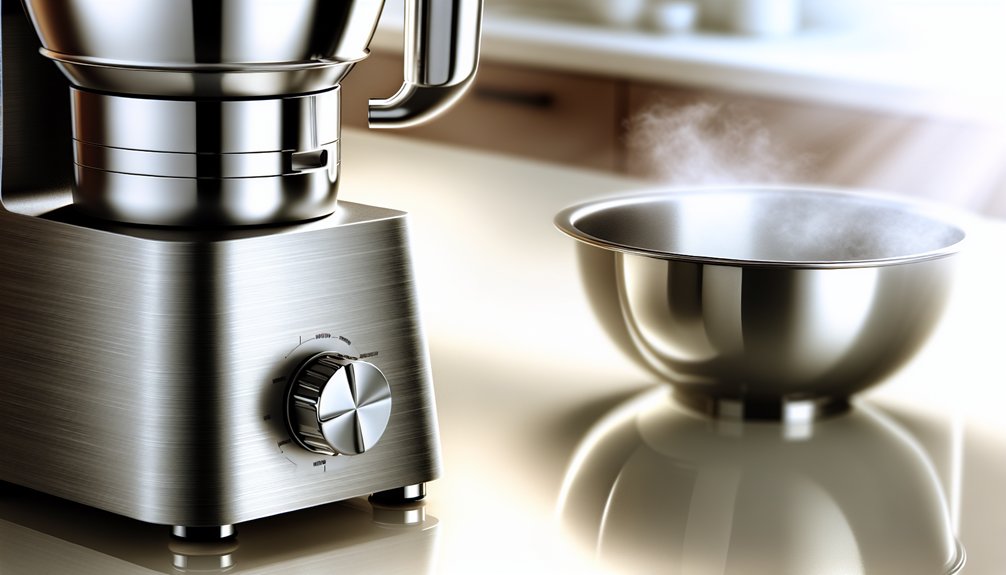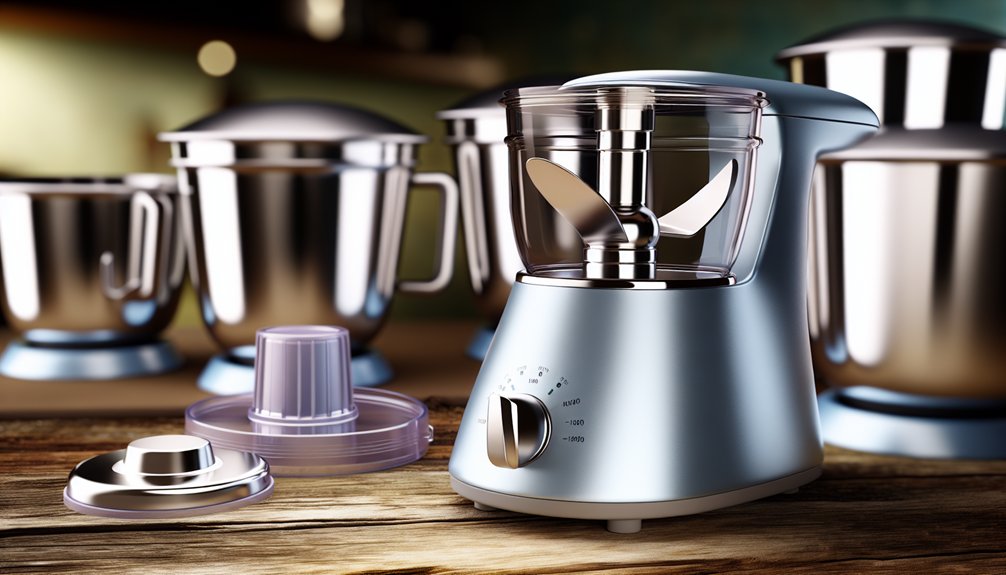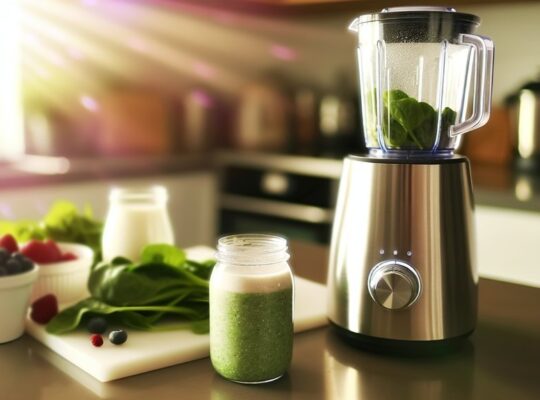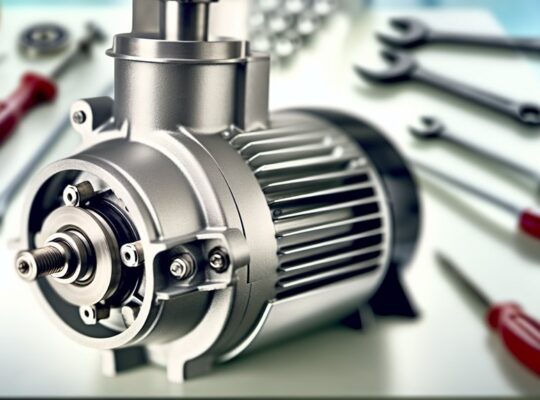When you’re making winter masalas and hearty soups, you’ll want a mixer grinder that handles long dry roasting and hot purees without burning out. Pick a 750W+ motor with copper windings, strong overload protection, and blades suited for both dry and wet work. Also consider heat-resistant jars and easy-clean parts. I’ll show which features matter and the best models to pick next, so you don’t end up stuck with a weak grinder mid-recipe.
Key Takeaways
- Choose a 600–750W motor with copper windings and thermal overload protection for steady torque on dry spices and fibrous roots.
- Prefer sharp angled blades and a dry-roast jar plus a flat-curved wet jar to crack spices and produce splash-free soups.
- Select stainless-steel or heat-resistant glass jars sized to your batch to avoid metallic odors and prevent overflow.
- Look for cool-start ventilation, noise-dampening mounts, and short duty-cycle limits clearly specified by the manufacturer.
- Maintain jars and seals—wipe after each use, warm jars before cold ingredients, and replace brittle gaskets monthly.
Why Wattage and Motor Type Matter for Winter Grinding

Why does wattage and motor type matter when you’re grinding winter masalas and making hearty soups? You’ll want a motor with enough wattage to handle tough, dry spices and fibrous root vegetables without overheating. Higher wattage provides steady torque for coarse to fine grinds, so cardamom, cloves, and whole peppercorns grind evenly and your ginger-garlic paste won’t strain the unit. Choose motors with thermal overload protection and copper windings; they run cooler and reduce fire risk during extended use for hot soups. For safety, inspect duty cycles—short bursts vs continuous run—and match recipes to capacity. You’ll also consider noise and vibration levels to avoid spills when processing hot ingredients. Proper motor choice preserves flavor and prevents dangerous motor failure. Models with overload protection and multiple jars offer the versatility needed for both masalas and soups.
Blade Design and Jar Choices for Roasted Masalas and Soups

How do blade angle and jar material change the way roasted masalas and hot soups turn out? You want sharper, angled blades for dry roasting pulses and whole spices — they shear and crack seeds cleanly without turning them into paste. For wet soups and purees, flatter, slightly curved blades create a smooth flow, reducing splatter and retaining texture. Choose stainless steel jars for heat tolerance and non-reactivity with acidic ingredients; they’re easy to sanitize. Use heat-resistant glass when you want to monitor consistency and avoid metallic odor transfer. Match jar size to batch: smaller jars for concentrated masalas, larger for soups to prevent overflow. Always secure lids, let hot ingredients sit briefly before blending, and use tamper tools safely to avoid burns or pressure buildup. Many Bosch models feature stone pounding technology that helps preserve authentic spice texture during grinding.
Top Features to Look For: Overheating Protection, Noise Level, and Ease of Cleaning

Wondering which features matter most when you’re grinding hot spices or whipping up steaming soups? You’ll want reliable overheating protection — thermal cut-offs and automatic shutoffs prevent motor damage when you process dense roasted masalas or simmered roots. Check for cool-start designs and proper ventilation so the unit can handle longer runs without stalling. Noise level matters: look for motors with sound dampening and rubber mounts; quieter units let you monitor aroma and avoid startling spills. Ease of cleaning keeps ingredients safe: detachable, smooth stainless-steel jars and sealed lids stop residue buildup; dishwasher-safe parts and accessible blade assemblies reduce bacterial risk. Prioritize clear maintenance instructions, sturdy seals, and replaceable filters to maintain performance and safety. Also consider the motor power and RPM (e.g., 550 watt models with 17000–20000 RPM) when selecting a unit for consistent results.
Best Models for Heavy-Duty Dry Grinding and Silky Purees

Looking for a grinder that can tackle hard, dry spices and still produce silky vegetable or lentil purees? You want robust motors, stainless-steel blades, and sealed jars that keep dust and heat out while you work. Choose models with multiple speed settings and a pulse function to control texture — coarse garam masala or smooth dal paste — and look for overload protection for safety. Consider attachments: a heavy dry jar for stone-like spices and a wet jar with fine sieving action. Visualize results:
- A glass jar releasing fragrant, evenly ground cinnamon and cloves
- A stainless-steel bowl yielding velvety pumpkin or carrot puree
- Tight lid seals preventing spills and contamination
- Easy-to-grip knobs for precise speed control
Pick certified brands with clear safety specs. Many top-rated 4-jar units offer overload protection and powerful 750W motors that handle both heavy dry grinding and wet grinding tasks efficiently.
Tips for Maintaining Performance During Cold-Weather Cooking

Once you’ve picked a heavy-duty grinder that handles dry spices and silky purees, keep its performance steady through colder months by adjusting use and care for low temperatures and drier indoor air. Wipe jars and gaskets after each batch to remove sticky residues from oils and sugars that thicken in cold; use a soft brush for blades to avoid nicking surfaces. Warm jars briefly with hot water before processing chilled ingredients to reduce strain on the motor. Check seals and lubrication points monthly—cold can stiffen rubber and thin grease—replace brittle gaskets immediately. Grind small batches of dry ingredients first, then wet, to prevent clogging. Store the appliance in a temperate cabinet, not an unheated garage. Always unplug before cleaning to ensure safety. Choose a model with a stainless steel jar and durable motor construction to resist cold-related wear.
Frequently Asked Questions
Can the Grinder Handle Grinding Frozen Ingredients Directly?
No, you shouldn’t grind frozen ingredients directly; they’ll strain motor and blades, risk jamming. Thaw slightly, chop into small pieces, remove ice, and pulse in short bursts while watching temperature to keep things safe and effective.
Is There a Recommended Jar for Making Hot Soups Safely?
Yes — you should choose a heat-resistant, stainless steel or borosilicate glass jar with a tight-sealing lid and steam vent; that prevents pressure buildup, tolerates hot liquids, guarantees safety, and preserves flavors without leaching or warping.
Do Warranties Cover Motor Issues From Frequent Winter Use?
Generally, warranties may cover motor failures from frequent winter use if damage stems from manufacturing defects; you’ll need to check terms, avoid overheating, follow prescribed jar and load limits, and keep service records for safe claim substantiation.
Can I Use the Mixer for Nut Butters and Seed Pastes?
Yes, you can, but choose a grinder with a powerful, durable motor and sturdy stainless-steel or hardened jars; pulse in short bursts, scrape sides, add neutral oil incrementally, and avoid overheating to guarantee safety and smooth texture.
Are Compatible Spare Parts and Jars Widely Available?
Yes — compatible spare parts and jars are generally available, but you’ll want to check model-specific parts, material (SS/plastic), seal quality, and vendor reputation; keep spare gaskets and lids for safe, contaminant-free grinding and storage.





